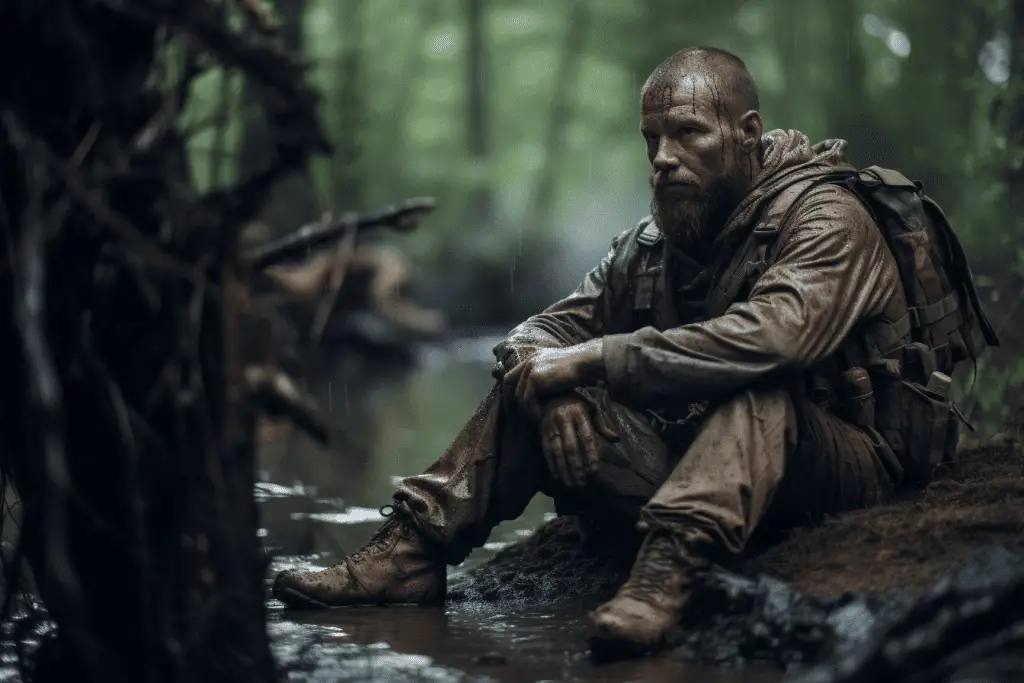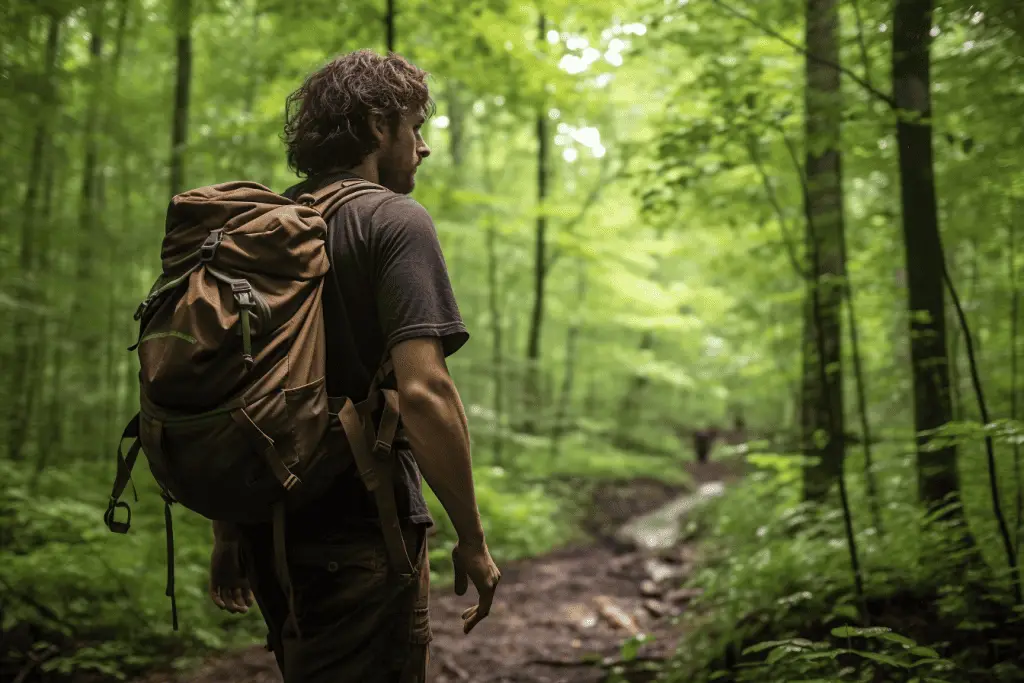Survivalist camping isn’t for everyone but it can be a lot of fun for the right person. So, what is survivalist camping?
Survivalist camping involves heading into the wilderness with minimal gear, relying on survival skills for food, shelter, and safety. It’s a self-reliant approach to experiencing the outdoors.

The Philosophy Behind Survivalist Camping
Survivalist camping is more than just an adventure; it’s a mindset, a way of life that takes you back to your most primal roots. It’s an experience that strips away the complexities of modern living, focusing on the essentials—food, water, shelter, and most importantly, survival.
Here are the 5 philosophies of survivalist camping:
1. Minimalism and Self-Reliance
The first principle is minimalism. You carry what you can on your back, and every item must have a purpose. On my first survivalist camping trip, I realized that half the gear I’d packed was superfluous. A spork could replace both a fork and a spoon, a sleeping bag liner could boost warmth without extra bulk, and so on. The fewer things you carry, the less you have to worry about, and the closer you get to nature.
2. Connection to Nature
Survivalist camping strengthens your relationship with the Earth. During a trip in the Rockies, I was far from any signs of human civilization. I had to rely on my understanding of the ecosystem to navigate, find food, and avoid danger. The experience deepened my respect for nature, reminding me that I’m a part of it, not apart from it.
3. Skill Over Gear
It’s easy to get caught up in the latest high-tech camping gear, but the true survivalist knows it’s skills that matter most. I once forgot to pack a proper filtration system and had to rely on boiling water and using natural filters like stones and sand. This episode underscored the importance of knowledge and improvisation.
4. Mental Toughness
Survivalist camping is as much a mental challenge as it is a physical one. You’re your only resource in times of need, and self-confidence is crucial. I’ve had moments, especially during the first few trips, where the isolation felt overwhelming. However, overcoming that mental barrier made me more resilient in life, teaching me that I’m capable of more than I thought.
5. The Art of Adaptability
If there’s one lesson the wilderness teaches you, it’s that conditions can change rapidly. During a trip in the Appalachian Trail, I encountered an unexpected snowfall. I had to adapt quickly, using leaves and branches to add insulation to my shelter. Adaptability is not just useful in the wild; it’s a skill that has helped me in various aspects of life.
Why I Love Survivalist Camping
Survivalist camping is more than just a form of recreation; it’s a life philosophy that hones your skills, challenges your limits, and brings you closer to the world you inhabit. It’s about stripping life down to its core and finding you have what it takes to survive, and more importantly, to thrive.
Necessary Skills for the Survivalist Camper
Survivalist camping is not for the faint-hearted; it requires a robust skill set that goes beyond setting up a tent and starting a fire. Whether you’re an experienced outdoorsperson looking to up your game or a beginner keen to venture into the wilderness, these are the essential skills you’ll need.
Here are the 9 skills you’ll need to go survival camping:
- Navigation Skills
- Map reading
- Compass use
- Natural landmarks
- Celestial navigation
- Fire-Making Techniques
- Flint and steel
- Fire bow
- Magnifying glass
- Shelter Building
- Tent pitching
- Lean-to construction
- Snow caves
- First Aid
- Treating cuts and burns
- Recognizing hypothermia and heat exhaustion
- Using a first aid kit
- Foraging and Hunting
- Identifying edible plants
- Trapping techniques
- Basic fishing
- Water Procurement and Purification
- Identifying natural water sources
- Boiling and chemical treatment
- Portable filters
- Knot Tying
- Basic knots
- Complex knots
- Utility knots
- Communication
- Whistle signals
- Ground-to-air signals
- Mirror reflections
- Mental Preparedness
- Psychological resilience
- Mindfulness
- Coping strategies
Ideal Locations for Survivalist Camping
Survivalist camping isn’t something you do just anywhere; location is key. If you’re new to this, you might want to start with locations that offer a balance of challenges and resources. Forests are a good starting point, especially if they’re close to water sources. They offer ample materials for shelter and fire, as well as opportunities for foraging and fishing.
Now, if you’re looking for something more challenging, mountainous regions will test your navigation and survival skills to the max. Weather conditions can change rapidly, and you’ll need to be resourceful to find food and water. But the vistas? Absolutely rewarding.

Desert landscapes are another extreme but fascinating option. You’ll need to be well-versed in water procurement techniques, as natural sources are scarce. Plus, temperatures can fluctuate dramatically between day and night. It’s tough but offers an unparalleled experience of solitude and resilience.
Don’t overlook cold climates like the Arctic tundra or high-altitude regions, either. These spots are for the truly seasoned survivalists, requiring expertise in building shelters that can withstand extreme conditions and skills in sourcing food when options are scant.
Whichever location you choose, make sure to research local laws and regulations. Some areas might be protected or have restrictions on activities like hunting and fishing. Always be respectful of the land and aim to leave no trace.
The table below will give you a good idea of where to go survivalist camping based on your current skill level.
| Skill Level | Recommended Locations | Key Considerations |
|---|---|---|
| Beginner | Local forests | Proximity to water, ample resources |
| Intermediate | Mountain regions | Rapid weather changes, limited resources |
| Advanced | Desert landscapes | Water scarcity, temperature fluctuations |
| Expert | Arctic tundra | Extreme cold, limited food options |
| All Levels | National Parks | Varying difficulties, regulations |
Planning and Preparation: The Steps Before Stepping Out
You’ve decided to embark on a survivalist camping trip—an experience that demands as much preparation as it does courage and skill. Your success and safety hinge on the meticulous planning you put in before stepping into the wilderness.
Here’s a guide on what you should focus on.
Research Your Location
It can’t be stressed enough: knowing your destination inside and out is crucial. Study the topography, climate, and local flora and fauna. Find out about potential hazards like wild animals, poisonous plants, or extreme weather conditions. Consult maps, read up on local regulations, and even talk to experts who have camped there before.
Make a Gear List
Survivalist camping is about minimalism, but it’s also about being prepared. Your gear list should be concise but comprehensive. From the essentials like a survival knife, fire starters, and water filtration systems, to additional items like a lightweight tarp or a compact first aid kit, everything should have a purpose. Triple-check your list to ensure you’re not over-packing or missing something vital.
Set Objectives and Plan Routes
It’s easy to get lost or disoriented in the wilderness, so having clear objectives and planned routes can be lifesavers. Whether you’re aiming to reach a particular summit, or simply survive for a specific number of days, having goals helps you stay focused. Plot your route on a map and have contingency plans in case things don’t go as expected.
Fitness and Skill Assessment
Your physical condition and skill set are just as important as your gear. Evaluate your fitness level and focus on areas that need improvement before your trip. If you’re planning on trekking through mountainous terrains, for example, leg strength and cardiovascular endurance are key. Similarly, brush up on the survival skills that will be most relevant to your chosen location.
Emergency Plans
No matter how experienced you are, unexpected situations can arise. Leave your itinerary with a trusted friend or family member, noting your expected return date. Know the nearest points of civilization and how to reach them. Familiarize yourself with emergency signals and carry a reliable means of communication, such as a satellite phone, for extreme situations.
By investing time in planning and preparation, you’re not just increasing your chances of having a successful survivalist camping trip—you’re also making it safer and more enjoyable. With the right preparation, you’ll be well-equipped to face the challenges and joys of the wilderness.
How To Go Survivalist Camping
Before you set off on a survivalist camping trip, research is your best friend. Know the ins and outs of your chosen location, including weather patterns and local wildlife. Once you’ve got that down, make a gear list that’s minimalist but covers the essentials. You’ll need to know your way around a map and compass, so get that sorted too.
Food and Water: Sourcing and Purification
When it comes to food, foraging and hunting are your go-to skills. Know what you can eat and what you should avoid. As for water, that clear stream might look inviting, but always purify before you sip. Boiling is a solid choice, but water purification tablets or filters can also do the trick.
Building Shelter: The Basics
The type of shelter you build will depend on your surroundings. In a forest, a lean-to with branches and leaves might suffice. If you’re in a more barren landscape, you may have to get creative, like digging a trench and covering it with whatever materials you can find. The goal is insulation and protection from elements.
Safety Measures: Navigating Risks and Hazards
Let’s talk safety. You’re out in the wilderness, so risks come with the territory. Always have a basic first-aid kit and know how to use it. Be aware of your surroundings to avoid encounters with dangerous animals or risky terrains. And hey, don’t forget to tell someone reliable about your plans and when you’re expected to return.
Ethical Considerations: Leave No Trace
You’re out there to immerse yourself in nature, so let’s keep it pristine for the next adventurer. The Leave No Trace principle is simple: take only photographs, leave only footprints. Don’t damage plants or disturb wildlife, and absolutely no littering. Whatever you bring in, make sure it comes back out with you.
By taking the time to plan, source your essentials wisely, build a solid shelter, maintain safety measures, and act ethically, you’re all set for a rewarding, responsible, and enriching survivalist camping experience. Trust me, the more you prepare, the more you’ll get out of it.
Is survivalist camping a bit too extreme? Why not try one of the other types of camping?
